Order Lepisosteiformes Higher classification Atractosteus Rank Species | Phylum Chordata Family Lepisosteidae Scientific name Atractosteus spatula Found in Lake Wylie | |
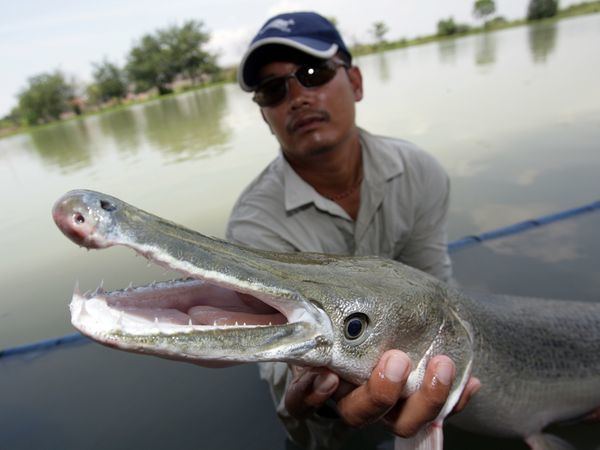 | ||
Similar Catfish, Snakehead, Common snapping, Nile perch, Sturgeon | ||
Alligator gar fish in freshwater aquarium
Alligator gar (Atractosteus spatula) are ray-finned euryhaline fish related to bowfin in the infraclass Holostei (ho'-las-te-i). The fossil record traces their existence to the Early Cretaceous over a hundred million years ago. They are the largest species in the gar family, and among the largest freshwater fishes in North America. Gars are often referred to as "primitive fishes", or "living fossils" because they have retained some morphological characteristics of their earliest ancestors, such as a spiral valve intestine which is also common to the digestive system of sharks, and the ability to breathe both air and water. Their common name was derived from their resemblance to American alligator, particularly their broad snout and long sharp teeth. Anecdotal evidence in several scientific reports suggest that an alligator gar can grow up to 10 ft (3.0 m) in length and weigh as much as 300 lb (140 kg); however in 2011 the largest alligator gar ever caught and officially recorded was 8 ft 5 1⁄4 in (2.572 m) long, weighed 327 lb (148 kg), and was 47 in (120 cm) around the girth.
Contents
- Alligator gar fish in freshwater aquarium
- Web extra trinity river texas alligator gar
- Anatomy
- Physiology
- Taxonomy and evolution
- Feeding behavior
- Spawning
- Natural range
- Outside natural range
- Early history
- Sport fish
- Commercialization and aquaculture
- Aquaria
- References
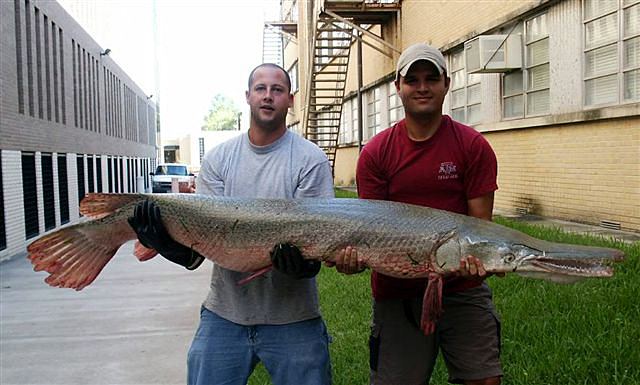
The body of an alligator gar is torpedo shaped, usually brown or olive fading to a lighter gray or yellow ventral surface. Their scales are not like the scales of other fishes; rather, they are ganoid scales which are bone-like, diamond-shaped scales, often with serrated edges, and covered by an enamel-like substance. Ganoid scales are nearly impenetrable and are excellent protection against predation. Unlike other gar species, the upper jaw of an alligator gar has a dual row of large sharp teeth which are used to impale and hold prey. Alligator gar are stalking, ambush predators, primarily piscivores, but they will also ambush and eat water fowl and small mammals they find floating on the water's surface.
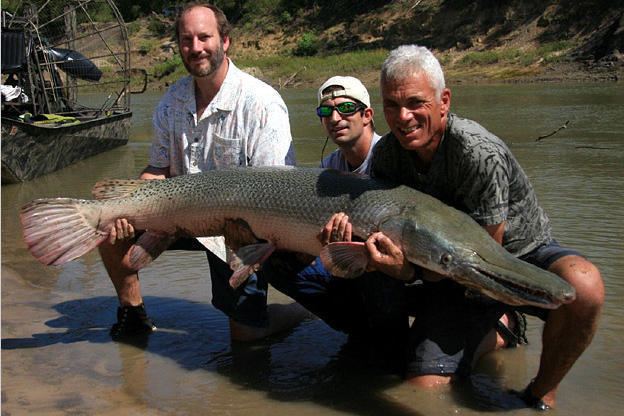
Populations of alligator gar have been extirpated from much of their historic range as a result of habitat destruction, indiscriminate culling, and unrestricted harvests. Populations are now located primarily in the southern portions of the United States extending into Mexico. They are considered euryhaline because they can adapt to varying salinities ranging from freshwater lakes and swamps to brackish marshes, estuaries, and bays along the Gulf of Mexico.

For nearly a half-century, alligator gar were considered "trash fish", or a "nuisance species" detrimental to sport fisheries; therefore, were targeted for elimination by state and federal authorities in the United States. The 1980s brought a better understanding of the ecological balance necessary to sustain an ecosystem, and eventually an awareness that alligator gar were no less important than any other living organism in the ecosystems they inhabit. Over time, alligator gar were afforded some protection by state and federal resource agencies. They are also protected under the Lacey Act which makes it illegal to transport certain species of fish in interstate commerce when in violation of state law or regulation. Several state and federal resource agencies are monitoring populations in the wild, and have initiated outreach programs to educate the public. Alligator gar are being cultured in ponds, pools, raceways and tanks by federal hatcheries for mitigation stocking, by universities for research purposes, and in Mexico for consumption.
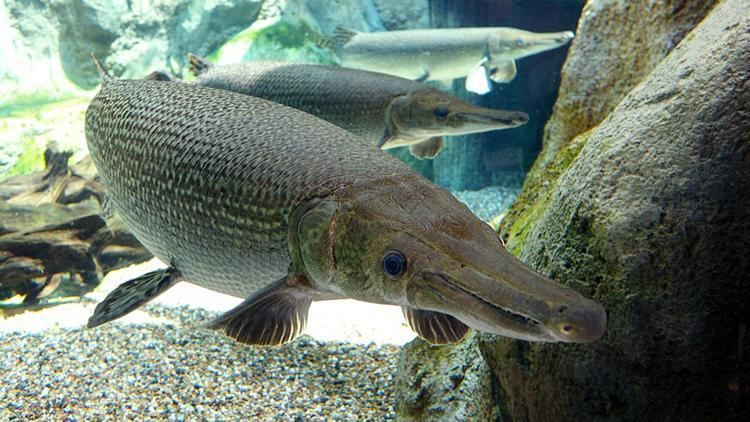
Web extra trinity river texas alligator gar
Anatomy
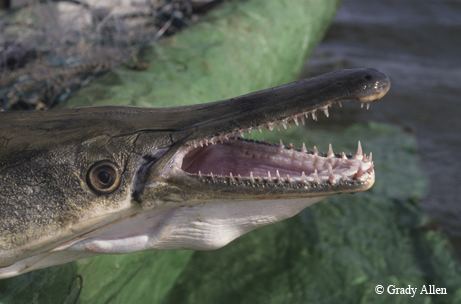
Alligator gar are the largest species in the gar family, and among the largest freshwater fishes found in North America. Mature alligator gar commonly measure 6 ft (1.8 m) in length, and weigh over 100 lbs. (45 kg). However, anecdotal reports suggest they can grow up to 10 ft (3m) in length, and weigh as much as 350 lbs. (159 kg). The largest alligator gar officially recorded was inadvertently caught in the net of fisherman Kenny Williams of Vicksburg, Mississippi while he was fishing the oxbow lakes of the Mississippi River on February 14, 2011. Williams was pulling up his net on Lake Chotard expecting to find buffalo fish, but instead discovered a large alligator gar tangled in his net. The gar was 8 ft 5 1⁄4 in (2.572 m) long, weighed 327 lb (148 kg), and its girth was 47 in (120 cm). According to wildlife officials, the fish was estimated to be somewhere between 50 and 70 years old; one report estimated the gar's age to be at least 95. Williams donated it to the Mississippi Museum of Natural Science in Jackson where it will remain on display.

All gars have torpedo-shaped bodies, but some distinguishing characteristics of adult alligator gar include their large size, heavy bodies, broad heads, short broad snouts, large sharp teeth and double row of teeth on their upper jaw. They are usually brown or olive fading to a lighter gray or yellow ventral surface. The dorsal and anal fins are positioned toward the back of their bodies, and their caudal fin is abbreviate-heterocercal, or non-symmetrical.
Physiology
Alligator gar have gills, but unlike other species of fish, with few exceptions, they also have a highly vascularized swim bladder lung that supplements gill respiration. The bladder not only provides buoyancy but also enables them to breathe in air which is why they are able to inhabit bodies of water in which most other fishes would die of suffocation. The swim bladder is connected to their foregut by a small pneumatic duct which allows them to breathe or gulp air when they break the surface, an action that is seen quite frequently on lakes in the southern United States during the hot summer months. The scales of alligator gar are not like the scales of other fishes which have flexible elasmoid scales; their bodies are protected by inflexible and articulated ganoid scales that are diamond-shaped, often with serrated edges, and composed of a tough inner layer of bone and hard outer layer of ganoin which is essentially homologous to tooth enamel, making them nearly impenetrable.
Taxonomy and evolution
Lacépède first described the alligator gar in 1803. The original name was Lepisosteus spatula, but was later changed by E.O. Wiley in 1976 to Atractosteus spatula in order to recognize two distinct extant taxon of gars. Synonyms of Atractosteus spatula include Lesisosteus [sic] ferox (Rafinesque 1820), and Lepisosteus spatula (Lacepede 1803). Fossils from the order Lepisosteiformes have been collected in Europe from the Cretaceous to Oligocene periods, in Africa and India from the Cretaceous, and in North America from the Cretaceous to recent times. Lepisosteidae is the only extant family of gar which has seven species all located in North and Central America. The fossil record traces the existence of alligator gar back to the Early Cretaceous over a hundred million years ago. Despite being a highly evolved species, alligator gar are often referred to as "primitive fishes", or "living fossils" because they have retained a few morphological characteristics of their earliest ancestors with seemingly little to no apparent changes, such as a spiral valve intestine which is also common to the digestive system of sharks, an abbreviate-heterocercal tail, and a swim bladder lung for breathing in both air and water.
Feeding behavior
Alligator gar are relatively passive, seemingly sluggish solitary fish, but voracious ambush predators. They are opportunistic night predators and are primarily piscivores, but they will also ambush and eat water fowl and small mammals that may be floating on the surface. Their method of ambush is to float a few feet below the surface, and wait for unsuspecting prey to swim within reach. They lunge forward, and with a sweeping motion grab their prey, impaling it on their double rows of sharp teeth.
Diet studies have shown alligator gar to be opportunistic piscivores, and even scavengers depending on the availability of their preferred food source. They occasionally ingest sport fish, but the majority of stomach content studies suggest they feed predominately on forage fishes such as gizzard shad as well as invertebrates, and water fowl. Diet studies have also revealed fishing tackle and boat engine parts in their stomachs.
Spawning
As with most ancestral species, alligator gar are long living, and sexually late maturing. Most females do not reach sexual maturity until after their first decade of life while males reach sexual maturity in half that time. The conditions must be precise for a successful spawning to occur. Preparation for spawning begins in the spring with the extended photoperiod and rising water temperatures, but flooding is also necessary to trigger the event. When rivers rise and spread over the floodplain, they create oxbow lakes and sloughs, and inundate terrestrial vegetation which in turn provides protection and a nutrient rich habitat for larval fishes, and fry. Once the water temperature has reached 68 to 82 °F (20 to 28 °C), and all the other criteria are met, gars will move into the grassy, weed-laden shallows to spawn.
Actual spawning occurs when a collection of males gather around gravid females, and begin writhing, twisting, bumping into and slithering over the tops of females, an activity which triggers the release of eggs. Males release clouds of milt to fertilize the eggs as they are released into the water column. The sticky eggs then attach to submerged vegetation, and development begins. It takes only a few days for the eggs to hatch into larval fish, and another ten days or so for the larval fish to detach from the vegetation and start moving about as young fry. Egg production is variable, and believed to be dependent on the size of the female. A common formula used for predicting the volume of eggs a female can produce is 4.1 eggs/gram of body weight which gives an average of about 150,000 eggs per spawn. The eggs of alligator gar are bright red and poisonous to humans if ingested.
Natural range
Alligator gar inhabit a wide variety of aquatic habitats, but most are found in the Southern United States in reservoirs and lakes, in the backwaters of lowland rivers, and in the brackish waters of estuaries, bayous and bays. They have occasionally been seen in the Gulf of Mexico. In Texas and Louisiana it is common to see large gars breaking the surface in reservoirs, bayous, and brackish marshes. They are found throughout the lower Mississippi River Valley and Gulf Coast states of the Southern United States and Mexico as far south as Veracruz, encompassing the following states in the United States: Texas, Oklahoma, Louisiana, Kentucky, Mississippi, Alabama, Tennessee, Arkansas, Missouri, Illinois, Florida, and Georgia. Reports suggest alligator gar were once numerous throughout much of their northern range, however valid sightings today are rare, and may occur once every few years. Records of historical distribution indicate alligator gar once inhabited regions as far north as central Kansas, Nebraska, Ohio, Iowa, and west-central Illinois where they are now listed as extirpated. The most northerly verified catch was in Meredosia, Illinois in 1922. There are now efforts to reintroduce alligator gar between Tennessee and Illinois as part of an effort to control invasive Asian carp.
Outside natural range
A few notable sightings of alligator gar have been reported outside North America. In November 2008, a broadhead gar, genus Atractosteus, measuring 5.2 to 6.4 ft (1.6 to 2.0 m) was caught in the Caspian Sea north of Esenguly, Turkmenistan by two officials of Turkmenistan Fishery Protection. Its species is unconfirmed but is believed to be an alligator gar.
On September 4, 2009 a 3 ft 3 in (0.99 m) alligator gar was found in Tak Wah Park in Tsuen Wan, Hong Kong. Over the next two days, at least 16 other alligator gar, the largest measuring 4.9 ft (1.5 m), were found in ponds in public parks in Hong Kong. Nearby residents reported the alligator gar had been released into the ponds by aquarium hobbyists, and had lived there for several years. However, after a complaint made by a citizen who falsely identified alligator gar as crocodiles, the use of terms like "horrible man-eating fish" had begun appearing in the headlines of some major local newspapers. Officials with Leisure and Cultural Services in Tak Wah Park removed all the alligator gar from the ponds because they were concerned the large, carnivorous fish might harm children. It is not unusual for the large sharp teeth and outward appearance of alligator gar to precipitate unreasonable fear in those unfamiliar with the species. Sensationalized reports have contributed to the misconception of predatory attacks by alligator gar on humans even though none of the reports have been confirmed.
On January 21, 2011, an alligator gar measuring 4 feet 11 inches (1.50 m) was caught in a canal in Pasir Ris, Singapore by two recreational fishermen. The fish was taken to a nearby pond where the owner confirmed it was an alligator gar rather than an arapaima as the men had initially thought.
There have been anecdotal reports of alligator gar captured in various parts of India but are believed to be the result of incidental releases by aquarium hobbyists and the like. In August 2015, an alligator gar was found entangled in cloth inside a well in Dadar where it had been living for quite some time. It was rescued by animal activists and returned to the well unharmed. In June 2016, a 3.5 ft Alligator Gar was caught from Subhash Sarovar Lake in Kolkata. Other incidents over the years have been random, ranging anywhere from captures in coastal waters during environmental assessments to captures in private ponds.
Early history
Native Americans in the south, and Caribbean peoples used the alligator gar's ganoid scales for arrow heads, breastplates, and as shielding to cover plows. Early settlers tanned the skins to make a strong, durable leather to cover their wooden plows, make purses, and various other items. Gar oil was also used by the people of Arkansas as a repellent for buffalo-gnats.
For nearly half a century, alligator gar were considered "trash fish", or a "nuisance species" by state and federal authorities who targeted them for elimination to protect game fish populations, and to prevent alleged attacks on humans, a claim that remains unsubstantiated with the exception of occasional injuries sustained from captured alligator gar thrashing around on the decks of boats. Fishermen participated in the slaughter of thousands of alligator gar believing they were providing a great service. In 1995, KUHT channel 8, a member PBS television station located on the campus of the University of Houston in Texas, distributed and broadcast the first video documentary ever produced on alligator gar. The documentary, "Alligator Gar:Predator or Prey?", debuted nationally in prime time during the July Sweeps, and according to the Nielsen rating report provided to KUHT, was the number one rated program of the evening. The documentary focused on the physiology and life cycle of alligator gar, addressed the destruction of habitat, the unregulated culling and over harvesting of alligator gar from various lakes in Texas and Louisiana, and expressed concerns for the future of the species at a time when they were still considered a "trash fish". A decade passed before any significant action was taken to protect and preserve the remaining populations of alligator gar in the United States. The Missouri Department of Conservation has since partnered with Tennessee, Arkansas, Kentucky, Illinois, Alabama, Mississippi, Texas, Oklahoma, and Louisiana in restoration and management activities.
Sport fish
The long time public perception of alligator gar as "trash fish", or a "nuisance species" has changed with increasing national and international attention on the species as a sport fish which some have attributed to features on popular television shows. Oklahoma, Texas, Arkansas, Mississippi, and Louisiana allow regulated sport fishing of alligator gar. Texas has one of the best remaining fisheries for alligator gar, and in concert with its efforts to maintain a viable fishery, imposed a one-per-day bag limit on them in 2009. The Texas state record, and world record for the largest alligator gar caught on rod and reel is 279 lb (127 kg), taken by Bill Valverde on January 1, 1951 on the Rio Grande in Texas. Alligator gar are also quite popular among bowfishers because of their large size, trophy potential, and fighting ability. The Texas state bowfishing record was set In 2001 by Marty McClellan with a 290 pounds (130 kg) alligator gar from the Trinity River. The all-tackle record was a 302 pounds (137 kg) alligator gar caught on a trotline in 1953 by T.C. Pierce, Jr. In 1991, fishing guide Kirk Kirkland anecdotally reported catching an alligator gar measuring 9 feet 6 inches (2.90 m) on rod and line from the Trinity River.
Commercialization and aquaculture
Declining populations of alligator gar throughout their historic range has resulted in the need to monitor wild populations and regulate commercial harvests. Alligator gar have a high yield of white meat fillets and a small percentage of waste relative to body weight. The meat is sold to wholesale distributors, and also sold retail by a few supermarkets with prices starting at around $3.00/lb. Fried gar balls, grilled fillets, and fillets boiled in water with crab boil seasoning are popular dishes in the south. There is also a small cottage industry that makes jewelry out of ganoid scales, and tans gar hides to produce leather for making lamp shades, purses, and a host of novelty items.
Atractosteus gars, including alligator gar, tropical gars, and Cuban gars are considered good candidates for aquaculture particularly in developing regions where their rapid growth, disease resistance, easy adaptation to artificial feeds as juveniles, and ability to tolerate low water quality are essential. Their ability to breathe in both air and water eliminates the need for costly aeration systems and other technology commonly used in aquaculture. In the Southern United States, as well as in parts of Mexico and Cuba, broodstocks have already been established, and are being maintained in their respective regions where they already are a popular food fish.
Aquaria
Despite the large size alligator gar can attain, they are kept as aquarium fish, though many fish labeled as "alligator gar" in the aquarium trade are actually smaller species. Alligator gar require a very large aquarium or pond, and ample resources in order for them to thrive in captivity. They are also a popular fish for public aquaria, and zoos. It is illegal in many areas to keep alligator gar as pets, but they will occasionally show up in fish stores. Alligator gar are highly prized and sought after for private aquaria, particularly in Japan. According to some reports, large alligator gar could fetch as much as US$40,000 in what some consider the "Japanese black market". In June 2011, three men from Florida and Louisiana were indicted on charges of illegally removing wild alligator gar from the Trinity River in Texas, and attempting to ship them to Japan for private collectors. The indictments resulted from an undercover sting operation by special agents with the U.S. Fish & Wildlife Service, the Texas Parks and Wildlife Department, and the Florida Fish and Wildlife Conservation Commission. The charges included violations of three separate provisions of the Lacey Act, specifically conspiracy to submit a false label for fish transported in interstate commerce; conspiracy to transport fish in interstate commerce in violation of state law or regulation; and conspiracy to transport and sell fish in interstate commerce in violation of state law or regulation. Two of the conspirators entered guilty pleas to one count, and the government dropped the other two charges against them. A third conspirator went to trial on all three counts, was acquitted on one count, and found guilty on two. The district court sentenced him to serve nine months in prison followed by one year of supervised release. The case was appealed, and on April 15, 2014, the appellate court affirmed the judgment of the district court.
